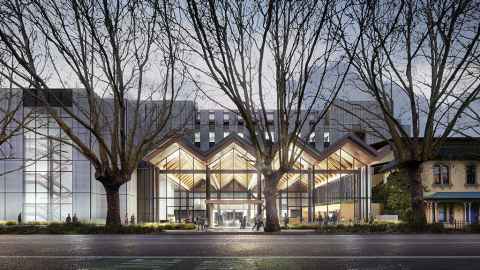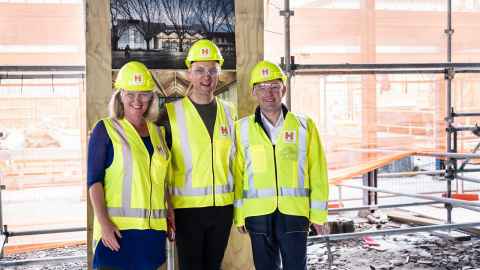University of Auckland building design receives highest ever 6 Green Star Design rating
12 August 2021
The University of Auckland’s Social Sciences Building has been awarded 93 points by the New Zealand Green Building Council achieving a 6 Green Star Design rating. This is the highest score awarded since the inception of the rating, putting the building in the ‘world leadership’ category.

Due to open in 2024, the 50-year-old structure (B201) is an ‘adaptive reuse’ project that will set new benchmarks for low carbon design and sustainability. It will send less waste to landfill, create less pollution through its construction and operation, and provide healthy, comfortable, and functional spaces for the many thousands of students and staff who will work, learn, research, and socialise within its walls. The design also focuses on acoustic performance, comfortable lighting, and excellent access to public transport, bike parking, and end-of-trip facilities.
University of Auckland Director of Property Services, Simon Neale, said that the University had set high standards for the project and for the design team and that achieving 6 Green Star certification was a priority from the very early stages.
“We are currently consulting on our Estate Strategy Te Rautaki Tūāpapa which is underpinned by our ambition to develop innovative campuses as sustainable ecosystems that are distinctive, welcoming, accessible, equitable, resilient and capable. These will support and activate student learning and well-being within a world-class research-intensive university in Aotearoa New Zealand.
“The B201 redevelopment embodies sustainable design and initiatives that will reduce carbon and increase energy efficiency. The finished building will improve student and staff experience and satisfaction. We are very pleased that Jasmax, Beca and others involved in the design were aligned with our priorities and truly met the brief,” he said.

The design of B201 includes the refurbishment of an existing building and addition of a spectacular new timber atrium to home the Faculty of Education and Social Work and the Faculty of Arts. The existing concrete cladding will be replaced with a new lightweight system ensuring the existing structure can be reused, while the weight saving allows the addition of extra floor area. Replacing the façade with a lightweight curtain wall will render the building earthquake-proof for another 50 years.
High performance solar glazing will reduce solar glare, while cleaner air is guaranteed by low emission paints and coatings and 50 percent greater ventilation rates from electric heating, ventilation, and air-conditioning systems. The naturally ventilated timber atrium will provide flexible multi-use teaching spaces for increased utilisation and timber partitioning throughout.
The design is predicted to use 75 percent less water than a standard comparable building. Water will be collected through a rainwater harvesting system while more than a tenth of the building's renewable energy will be generated on site. The University will measure and report the environmental performance of at least 80 percent of the building's floor space, with electrical and water metering and monitoring built in.
Chris Scott, principal and senior architect at Jasmax, designers of Building 201, said that Jasmax was pleased to be able to meet the University’s 6 Green Star brief and was also committed to setting industry-leading carbon targets in response to the 2019 New Zealand Climate Change Response Amendment Act.
“This Green Star certification marks an exciting development in our efforts to partner with our clients to meet net-zero carbon across new buildings over the next decade. Jasmax is particularly pleased to work with the University which shares our commitment to sustainable design. We want to ensure our projects have longevity and are part of the solution to reducing the impacts of climate change,” he said.
Simon Neale said the project was supported by the New Zealand Government’s Covid-19 response fund (shovel-ready) through the Infrastructure Reference Group.
“This has enabled the University to support employment in the vertical infrastructure sector within New Zealand and the Auckland region across a diverse range of professional and trade skills including the Jasmax architectural team, Beca engineers, Precon Project Management, Hawkins construction and multiple component manufacturers and fabricators,” he said.
....achieving 6 Green Star certification was a priority from the very early stages.
Beca Technical Director and Building 201 Project Lead, Richard Walsh, says the rating was an outstanding outcome driven by a whole-of-life approach to cost and carbon reduction, while improving health and well-being, supply chains for materials, construction practices, and environmental impacts.
“An assessment of the building's life cycle has found emissions for its construction and operation over its lifetime will be almost 60 percent less than an equivalent new build.
“For Building 201 to receive this 6 Green Star Design rating is testament to the vision of the University and the passion and commitment of our design team members, supported by our sustainability specialists, to deliver to the University’s sustainability aspirations,” he said.
The design rating forms the first part of the project's 6 Green Star Design and As-Built certification, with a final As-Built rating awarded based on the finished building. NZGBC Chief executive Andrew Eagles says 6 Star ratings are reserved for truly world-leading projects.
"This project highlights how we can avoid bowling our existing spaces and instead adaptively re-use them – massively slashing our carbon emissions while creating a space fit for the future,” he said.
"To meet our climate change goals and create a zero-carbon future, we need more of the leadership and partnership demonstrated here by the likes of the University of Auckland, Jasmax and Beca.”
- Green Star is Australasia's largest holistic sustainable rating system for buildings, fitouts and communities. Green Star ratings are awarded for 4 Star projects (considered best practice) through to 6 Star (considered world leadership). Green Star is run by the New Zealand Green Building Council (NZGBC), Aotearoa's leading sustainable building not-for profit. The NZGBC advocates for regulatory and industry-wide change, provides independent and trusted certification, and supports New Zealand on its path to a low carbon future. New Zealand Green Building Council
- Jasmax is one of Aotearoa New Zealand’s leading architecture and design practices. Operating in the country since 1963, the organisation has been responsible for some the country’s most iconic and forward-thinking designs. Leaders in sustainable design, Jasmax are a multi-disciplinary, bicultural design practice offering services across architecture, interior design, urban design, landscape architecture and brand design. Jasmax
- Beca is one of the largest and most diverse professional consultancy services companies in the Asia-Pacific. The employee-owned company assists clients across a wide range of markets including industrial, power, buildings, government, transport and water. As well as numerous engineering consultancy services, it provides holistic project services from concept to commissioning, including project management, cost management, planning, urban design, architecture, land information, valuations and software services. Beca
Media enquiries:
Lisa Finucane
Mobile: 021 677 216
Email: l.finucane@auckland.ac.nz